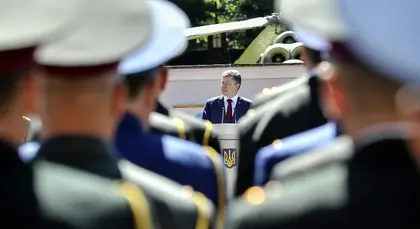Meanwhile, NATO reported a renewed buildup of
Russian military forces on its border with Ukraine.
The plan calls for the release of all
illegally held government buildings in Donetsk and Lugansk regions and pledges
the restoration of buildings damaged during the course of the conflict. It also
promises to exonerate all rebels who lay down their arms and are not guilty of
serious crimes.
JOIN US ON TELEGRAM
Follow our coverage of the war on the @Kyivpost_official.
On the political front, the peace proposal
calls for decentralization of power, granting regional authorities more
autonomy, as well as the protection of the Russian language and early local and
parliamentary elections.
Point four of the proposal is the creation of
a 10km buffer zone on the Russian-Ukrainian border to prevent the influx of
Russian arms and fighters, an element that deputy head of the presidential
administration Valeriy Chaly said was crucial for the plan to succeed.
“It is impossible to implement a cease fire
without having control of the dangerous sections of the border. There is no
alternative,” he said, speaking at a press conference earlier in the day.
The day of the announcement was punctuated by
mounting evidence of arms and military vehicles crossing into Ukraine from
Russia, including a post on Facebook by Interior Minister Arsen Avakov alleging
concrete proof of Kremlin involvement.
A claim by parliament speaker Oleksandr
Turchynov that government forces had successfully sealed the border with Russia
was subsequently denied by National Security and Defense Council spokesman
Volodymyr Chepovy.
‘The border is not completely controlled by
our law enforcers,” Chepovy told Interfax.
Turchynov’s claim also elicited a strong
response from representatives of separatist forces.
“It can, of course, be said that there is a
garden blooming on the moon, but we all understand that it’s not so… There is a
war going on here and they have not taken anything under their control here,
nor have they erected any walls or barbed wire,” said Andriy Purhin, first
deputy prime minister of the self-proclaimed Donetsk People’s Republic,
according to Interfax.
The announcement of the peace plan follows a
period of active diplomacy by Poroshenko, which culminated in a telephone conversation
with Vladimir Putin on June 19, during which the two leaders discussed the
plan’s key points. Putin once again insisted on an immediate end to Kyiv’s
military operation in the east, according to the Kremlin’s press service.
“The President of Russia expressed hope that
in implementing this plan, priority attention will be given to resolving key
problems that have caused strong protests by the people living in these
regions,” reads the statement on the Kremlin’s website.
It is unclear whether the peace plan will
bear fruit. Most notably it includes no offer of negotiation with those who
have seized power in Donetsk and Lugansk.
“There can be no talks with the Donetsk and
Lugansk People’s Republics. Negotiations are possible only with those who share
the peaceful plan of the president,” Iryna Gerashchenko, the president’s envoy
for peace in Donetsk and Lugansk, said on Thursday.
A ceasefire was also flatly rejected by
representatives of separatist forces when the president’s plans for a ceasefire
first surfaced on June 18.
“This proposal by Poroshenko to lay down our
arms is simply a tactical ploy. If people fall for it, there will be a new
mopping-up operation. We will not put our weapons away,” said a spokesman for
self-proclaimed Donetsk People’s Republic, Myroslav Rudenko, in comments
carried by Interfax.
Kyiv Post staff writer Matthew Luxmoore can be reached at mjluxmoore@gmail.com.
You can also highlight the text and press Ctrl + Enter




